Last issue:
Ukrainian artist
SEVERAL READERS wrote to ask about artist Ivanka Demchuk, whose work was featured on Response’s Fall/Winter 2021 cover, on our Christmas notecards, and on the pages illustrating our Advent readings.
Demchuk was born and lives in Lviv, Ukraine. Her parents, both doctors, suspected she had some eye afflictions and took Ivanka to see an ophthalmologist when she was a child. Her doctor recommended an unusual remedy for her diagnosis of farsightedness and astigmatism: Demchuk was to cover one eye and paint, color, and sculpt relying on her other eye to increase its visual load.
Demchuk was thrilled with the prescribed treatment and threw herself into art — joining art clubs and pouring over classic paintings. Eventually, she earned a bachelor’s and master’s degree from Lviv National Academy of Arts.
Her mother fretted over the unreliable income of an artist, but after art school, Demchuk chose an even more narrow specialty: sacred art.
“My favorite topics are victory and loss; the birth of life and death; motherhood; sacrifice; human transformation,” Demchuk said. “These themes are close to my heart as they often overlap with current pressing issues.”
Demchuk wants her art to reduce the distance between the creator and creation. “In my art, God comes to man again in human form,” she said. “My saints are placed in modern interiors or imaginary landscapes, close to humans today. We can look at the traditional icons but see in them the people around us.”
Before we went to press, Demchuk wrote to say she and her family were safe, for now, in Lviv, Ukraine. You can find her full interview at stories.spu/Ivanka-demchuk.
Carol Redfield
Adjunct Professor of Nursing, SPU School of Health Sciences
I want to provide some background to the article about SPU nursing students working with the Phinney Neighborhood Association [Fall/Winter 2021,
“Bringing healing to the table”]. Nursing instructor Carol McFarland brought the first group of student nurses to PNA in early 2020, and I helped advance the partnership between PNA and SPU’s nursing students who completed their 10 weeks of community health hours there under my supervision.
The nursing students and I were able to get Lahai’s executive director and health care staff to offer medical services at the PNA. (Lahai Health provides a mobile medical clinic to underserved communities in King and Snohomish counties.) We also connected Medical Teams International to the PNA’s hot
meal site and secured significant funding from the Evangelical Chinese Church to help cover the cost of MTI’s monthly mobile dental clinics there.
I wanted to mention these organizations to acknowledge their huge, ongoing contributions to better health in our community.

 Steven D. Martinson ’71
Steven D. Martinson ’71
Lutz, Florida
I wanted to take a moment to congratulate you on the most recent edition of Response [Fall/Winter 2021]. I was heartened to find such excellent quality articles. The design of the edition is likewise outstanding. In addition to Response, my wife, Elizabeth [Timmermans Martinson ’73], and I receive university publications from Western Washington University, the University of Washington, and the University of Arizona. Response is the best of those publications. Thank you for this issue.
Paul Andrews ’70
North Attleboro, Massachusetts
In the Fall/Winter Response, I read this observation: “The system of higher education was created by the privileged for the privileged,” which I took to imply a pejorative sense. On another page an observer offered that SPU is made up of rich, white kids.
I know 50 years makes a huge difference in culture and in the standard of living, but in my four years at Seattle Pacific College, I rubbed shoulders with students whose parents mostly worked in automobile garages, who farmed, who ran small family businesses, taught school, sold insurance, or served as ministers. Many students came from small towns where economic opportunity was modest at best.
It was also clear in the 1960s that many Free Methodist families — living at the midpoint on the socioeconomic scale or even lower — made great sacrifices to send their sons and daughters to SPC. In the same spirit, they also supported the school financially and sustained its existence. As a general
observation, I failed to note any “privilege” in that.
Candy Gray
Kennewick, Washington
The article, “When the holidays hurt” was timely for so many. My husband, Fred, passed away of COVID in March 2020. I am a member of a Facebook page for COVID widows and widowers. When I read this article, I knew it would benefit and give some comfort to many in this group. COVID has been
hard for so many and the holiday season makes the loss of loved ones even more difficult.




